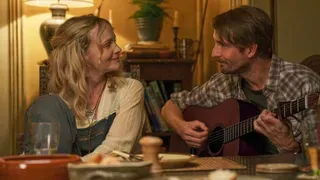June 15, 2016
GLBT History Museum Presents Traveling Exhibition of Gay Erotic Art, 1950s-1990s
READ TIME: 5 MIN.
From July to October, the GLBT History Museum will present a historical retrospective of erotic illustrations by artists who worked for gay men's magazines from the 1950s to the 1990s. "Stroke: From Under the Mattress to the Museum Wall" originated at the Leslie-Lohman Museum of Gay and Lesbian Art in New York City. The San Francisco show is its only scheduled West Coast appearance.
Curated by artist Robert W. Richards, this exhibition of a largely forgotten body of work not only explores the male form, but also offers an examination of erotic fantasies as experienced through publications that were available at nearly every newsstand in America, but that men often hid under their mattresses for fear of being discovered. The exhibition will feature originals of illustrations from the magazines, along with related work that has never been seen publicly.
"Many of the early magazines pretended to be bodybuilding, strength and health journals," says Richards. "Sometimes they were called anatomy guides for artists. However, most of the men bought these magazines because they were gay. It was nearly their only opportunity to see handsome, well-made, virtually naked men. Buying one of these publica�tions required an act of courage, espe�cially if the small-town drugstore owner had known the buyer and his family most of their lives."
"Stroke" will run from July 21 to October 16, 2016, at the GLBT History Museum, located at 4127 18th St. in San Francisco. A public opening reception is set for Thursday, July 21, from 7:00 to 9:00 p.m. In addition, curator Robert Richards will join Leslie-Lohman Museum Director Hunter O'Hanian in presenting a gallery talk on Friday, July 22, from 5:30 to 6:30 p.m. Admission for each event is $5.00; free for members of the GLBT Historical Society. For more information, visit www.glbthistory.org.
ABOUT THE CURATOR
Time Out New York notes that Robert W. Richards "has drawn everything from Paris haute couture to album covers and Broadway and cabaret posters and stars." But for his many admirers, Richards is best known for his skillful and captivating drawings of sexually charged men. Next magazine states, "He's bound to go down in history as one of the gay community's greatest and most influential artists."
Now in his fifth decade of drawing, Richards is highly productive as an artist -- and he occasionally pauses from his own work to curate exhibitions. At the Leslie-Lohman Museum, Richards has curated "The Gods of Erotica" and a Peter Berlin retrospective. At the Museum of the Society of Illustrators, he curated "The Line of Fashion." According to Richards, "If something moves me, I'm willing to do the work to share it with people who otherwise might not have an opportunity to see what I've been fortunate enough to see."
ABOUT THE GLBT HISTORY MUSEUM
Open since January 2011, the GLBT History Museum is the first full-scale, stand-alone museum of its kind in the United States. Its Main Gallery features a long-term exhibition on San Francisco LGBTQ history, "Queer Past Becomes Present." Its Front Gallery and Community Gallery host changing exhibitions. The institution also sponsors docent tours, history discussions, author talks, film showings and other programs.
The museum is a project of the GLBT Historical Society, an archives and research center that collects, preserves and interprets the history of gay, lesbian, bisexual and transgender people and the communities that support them. Founded in 1985, the society maintains one of the world's largest collections of LGBTQ historical materials. For more information, visit www.glbthistory.org.
ABOUT THE LESLIE-LOHMAN MUSEUM
The Leslie-Lohman Museum of Gay and Lesbian Art is the world's first museum dedicated to exhibiting and preserving gay and lesbian art and to fostering the artists who create it. The institution maintains a permanent collection of more than 30,000 objects; presents six to eight major exhibitions annually; and sponsors artist talks, film screenings, readings, a quarterly art newsletter titled The Archive, a membership program and a research library.
In 2015, the Leslie-Lohman Museum merged with the Leslie/Lohman Gay Art Foundation Inc., a nonprofit founded in 1987 by Charles W. Leslie and Fritz Lohman, who have supported gay and lesbian artists for more 30 years. Located at 26 Wooster Street in the SoHo neighborhood of New York City, the museum embraces the rich creative history of the gay and lesbian art community by informing, inspiring, entertaining and challenging all who enter its doors. For more information, visit LeslieLohman.org.
HISTORICAL BACKGROUND
In the 1950s, when a large-scale effort sanctioned by the U.S. government was underway to crack down on what was termed "sexual perversion," gay life was pushed into the closet. Regardless of those strictures, gay men still needed to explore their own sexuality and identity.
As a result, a number of magazines became avail�able on drugstore magazine racks and newsstands nationwide. Early titles such as Grecian Guild Pictorial and Tomorrow's Man featured the work of artists Tom of Finland and Bob Mizer, who were recently the subject of a joint retrospective at the Museum of Contemporary Art (MOCA) in Los Angeles.
Although law-enforcement authorities tried to ban sending images of naked men through the mail, by the mid-1960s, the United States Supreme Court allowed their distribution. By the late 1960s, with the impact of the sexual revolution, the rise of feminism and the growth of the gay liberation movement, the demand for the magazines mushroomed.
Titles in the 1970s and 1980s included Blueboy, Torso, Honcho, Mandate and InTouch. Each issue typically featured work by major illustrators such as Antonio Lopez, Mel Odom, George Stravrinos and Richard Rosenfeld. Many also produced work for mainstream publications such as Vogue, Harper's Bazaar, The New York Times and Playboy. It was not until the advent of the VCR, then the DVD and ultimately the Internet, that the magazines' popularity declined and the demand for erotic illustrations waned.
ARTISTS IN THE EXHIBITION
"Stroke" will include 24 original illustrations, most drawn from the Leslie-Lohman Museum's vast collection. Other pieces have been borrowed from private collectors and in some cases from the individual artists. Included in the exhibition will be artwork by Neel Bate (Blade), Michael Breyette, Michael Broderick, Harry Bush, Jim French (Colt), Oliver Frey, Kevin King (BEAU), Michael Kirwan, Touko Laaksonen (Tom of Finland), Antonio Lopez (Antonio), David Martin, Donald Merrick (Domino), Kent Neffendorf (Kent), Olaf Odegaard (Olaf), Mel Odom, Dominic Orejudos (Etienne), Beno�t Pr�vot, George Stavrinos, Rex, Robert W. Richards, Richard Rosenfeld, William Schmelling (Hun), George Quaintance and Frank Webber (Bastille).
STATEMENT FROM THE LESLIE-LOHMAN MUSEUM
Leslie-Lohman Museum Director Hunter O'Hanian notes that "this work has never been collected in one museum exhibition before. It was one of the most popular shows in our history when it was here in New York. What Robert Richards has done is pull together work that played a vital role in people's lives. This exhibition is important for people who remember the magazines and who will get to see the some of the original illustrations they loved years ago along with some recent work. For those in their 20s and 30s, the exhibition will be an opportunity to understand the way that gay men explored their own sexuality and intimacy a generation ago. We are thrilled to bring these fine works to San Francisco and the GLBT History Museum."






